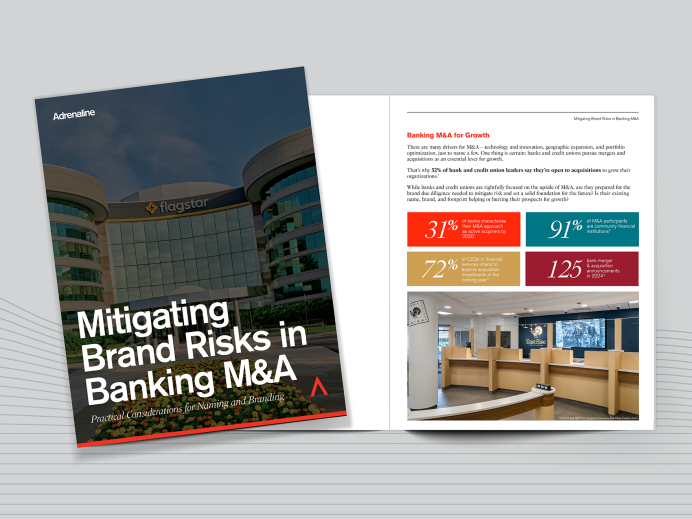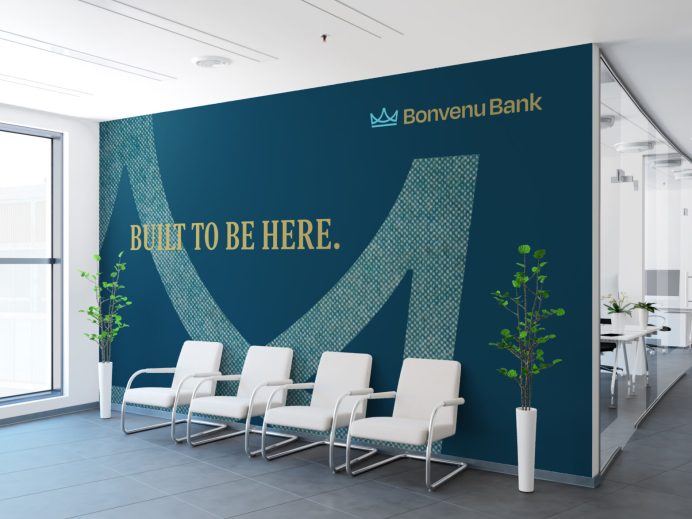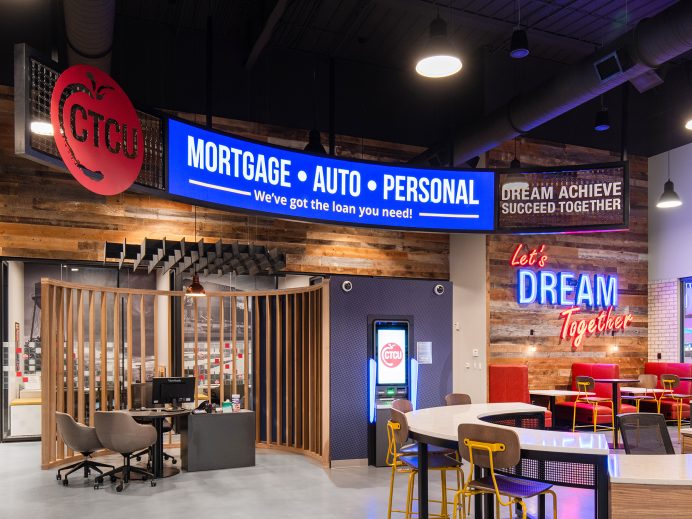A conversation with Chief Brand Officer Juliet D’Ambrosio on EA Live’s “Brand Naming: An Expert How-To for Newbies”
Data from Adrenaline’s Financial Industry Pulse Report finds that 75% of financial brands surveyed at the banking industry’s largest event believe that brand “critically impacts their business value,” but 66% haven’t touched their brand since before COVID. That’s two-thirds of institutions needing to, at the very least, refresh their brands. Undoubtedly some proportion will need a complete brand overhaul, including a new name. “Of course, brands can benefit from rebranding, but it should be authentic,” according to a recent branding analysis . “It should not stop at just tweaking your logo or incorporating social issues into your ads.” But where should it start?
The reality is that brand names are all around us – intertwined and ingrained in our daily lives in ways that are sometimes hard to explain – but few people have thought about the brand naming process unless they’ve gone through it themselves. “I feel like brand naming is one of those things that kind of feels to some people like magic,” says Kendra Rainey, Director of Strategy & Content at Edgar Allan in her recent conversation with Juliet D’Ambrosio, Chief Brand Officer at Adrenaline on the EA Live webcast. “It’s obviously not magic. Maybe a little bit of science, plus process and creativity, but it feels like this really big deal to a lot of clients.”
To help demystify the brand naming process, Kendra and Juliet sat down together 2023 style, in a virtual chat, to talk all things branding and naming. Watch the full video of the EA Live webcast and keep reading for excerpts where they explore some key questions, including the essentiality of a brand name and inventive ways to get clients over the fear factor in the naming process.
How important is a brand’s name really in the grand scheme of things?
A name is the single most important asset of a brand. There are all sorts of levers that go around and enrich the experience of a brand, the memorability of a brand, the ability for a brand to stand out and connect with the people that it needs to attract. But I say that the brand name is so critical, so important, because it becomes your calling card in every single place that your brand will live, including in the verbal sense when people are talking about the brand. You’re not always going to have a chance to show your logo. You’re not always going to have a logo when you type in a URL. So, the brand name becomes the hardest working part of the brand identity.
And because it has to live in all places, every time the brand comes up, the name is going to be attached to it. And that’s just not true about the tagline, the photography, the colors, the digital experiences, etc. So, I think the name is utterly critical, and that’s another reason why there really is an art and a science to naming. And I’ve thought about this in relation to brand name websites or brand name generators that you could just click through. That’s a thing that exists and there’s a reason it costs a hundred dollars to go that route. There’s room in the market for that, but there is a reason that you invest in a brand name.
Do you find this part of the process of creating a brand particularly intimidating to some clients?
Yes, and I think there are a few reasons why. All brand change is hard. Change is hard for any human being. And when you’re doing something as formative as a name change – going from version 1.0 of the name to version 2.0 of how your business has evolved – that’s scary because you had a connection, an attachment to the name in the past. Brand change is scary when it’s actually the result of brand birth, where you are taking a product from concept into reality. That’s very intimidating. The landscape of trademark and ownability around brands is intimidating. The idea that there’s something mystical about it goes into it, too. Finally, I think it’s intimidating because it is so incredibly subjective.
We are all moved by our gut feelings and we have subjective reactions to names. In some cases, we react to names even more so than we do to visual expressions of the brand, because we all have names and we all name things all the time. So, there is that level of subjectivity. Especially for clients who are dealing with complex organizations, lots of decision-makers at the table with lots of ideas, lots of subjective opinions. How are you going to put all of that together and come up with a name that is ownable and that represents real change for who you are and a path forward? So, yes, highly intimidating, but also highly exciting. It’s where the rubber of brand strategy begins to meet the road in expression of the brand. Up until this point, it can feel very theoretical or like a plan or path. But this is where it becomes something that people can react to. So, it’s equal parts thrilling and intimidating.
I think sometimes naming makes the decision so insanely scary to some clients that they get analysis paralysis. How do you help clients work through that problem?
Well, great question. It is a real fear for clients. I have found two strategies to be particularly helpful. One is that I ask clients to sleep on it. It sounds like very simple advice, but the idea is that when you sleep on it and what you wake up the next day or three or four days later, the name that you remember, the name that speaks to you the most, that’s the name that you trust in your gut. Because your gut is really just your intuition, and your intuition is your subconscious working behind the scenes to ultimately lead you to the right direction. I think people trust in that and have confidence there. That’s the “woo-woo” or client psychology answer. But I do believe it’s true.
The second answer is for when we’re coming down to two names. I just worked with a client and their board on this very question. There were two names and they were equally great, and there were equal factions around the board team that loved both names equally. And we say that we can talk until we’re blue in the face about the names that each faction thinks are the strongest. So, let’s ask people in your market. Let’s ask the audience. And that’s what we do. It does not have to be a lengthy process. What we recommend is testing that takes place not among your current customer set or current customer base, but testing prospects, testing people who you want to be your customers, and sharing that name.
And I have never not been surprised by the findings. Even if testing ultimately reveals the name that we’ve recommended, that is our company favorite, that is our recommendation, there are still nuances to what we learned through testing that we wouldn’t have expected. Testing really helps to do two things. One is to release the fear saying “Yep, this is right.” And anytime somebody gets nervous, say, “Look at this chart. Remember, 75% of people love this name. This is the right direction for you.” It helps release the fear. But it also helps us in the next stage, which is identity development. Because we have a new more nuanced understanding about what people are hearing or associating with names, we can use that as a leaping-off point for how we’re going then take the next steps and make that brand experience comes to life.
For more information on how to choose a brand name or to speak with one of our brand strategy experts, contact us at info@adrenalinex.com. Stay tuned to Adrenaline’s Insights channel for branding best practices. Be sure to also stay tuned in to Believe in Banking as it highlights industry news and views for banking leaders.
Adrenaline is an end-to-end brand experience company serving the financial industry. We move brands and businesses ahead by delivering on every aspect of their experience across digital and physical channels, from strategy through implementation. Our multi-disciplinary team works with leadership to advise on purpose, position, culture, and retail growth strategies. We create brands people love and engage audiences from employees to customers with story-led design and insights-driven marketing; and we design and build transformative brand experiences across branch networks, leading the construction and implementation of physical spaces that drive business advantage and make the brand experience real.




